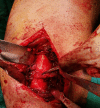Collagen/Nano-hydroxyapatite Composite Scaffold Application with Exchange Reamed Nailing Accelerates Bone Union and Improves Quality of Life in Atrophic Femoral Shaft Nonunions: A Retrospective Comparative Study
- PMID: 35251504
- PMCID: PMC8854517
- DOI: 10.1007/s43465-021-00545-9
Collagen/Nano-hydroxyapatite Composite Scaffold Application with Exchange Reamed Nailing Accelerates Bone Union and Improves Quality of Life in Atrophic Femoral Shaft Nonunions: A Retrospective Comparative Study
Abstract
Background: Our aim in this study was to evaluate the effect of exchange intramedullary nailing in femoral shaft atrophic nonunions and the use of collagen/nano-hydroxyapatite composite scaffold applied in addition to the cancellous iliac crest autograft on the union, return to work, and quality of life.
Materials and methods: Fifty-four patients with an atrophic nonunion in the isthmic region of the femoral shaft were included in the study. The patients were divided into two groups. Group A consisted of 24 patients who underwent collagen/nano-hydroxyapatite composite scaffold in addition to exchange intramedullary nailing and iliac autograft, while group B consisted of 30 patients without scaffold. Short Form-36 (SF-36) questionnaire scores, union rates, time to union, return to work were complications were compared.
Results: Mean age of patients was 47.5 ± 14.1. The mean follow-up period was 3.56 ± 1.88 years. There was no statistically significant difference between Group A and B in terms of age, gender, smoking and alcohol use, and trauma mechanism. Time to union and return to work were statistically significantly shorter in Group A than in Group B (p = 0.004, p = 0.001). All of the SF-36 survey scores at month six were better in Group A. In the first year, mental health and general health perception were still statistically better in group A (p = 0.009, p = 0.008).
Conclusion: In the treatment of atrophic nonunions of the femoral shaft isthmic region, the use of collagen/nano-hydroxyapatite composite scaffolds together with exchange intramedullary nailing affects the union positively. This positive effect also brings about earlier return to work and better quality of life.
Keywords: Collagen; Exchange nailing; Femur; Hydroxyapatite; Nonunion; Scaffold.
© Indian Orthopaedics Association 2021.
Conflict of interest statement
Conflict of interestThe authors declare no potential conflicts of interest with respect to the research, authorship, and/or publication of this article.
Figures






Similar articles
-
Augmentative antirotational plating provided a significantly higher union rate than exchanging reamed nailing in treatment for femoral shaft aseptic atrophic nonunion - retrospective cohort study.BMC Musculoskelet Disord. 2019 Mar 25;20(1):127. doi: 10.1186/s12891-019-2514-3. BMC Musculoskelet Disord. 2019. PMID: 30909909 Free PMC article.
-
Aseptic femoral nonunion treated with exchange locked nailing with intramedullary augmentation cancellous bone graft.J Orthop Surg Res. 2022 Jul 6;17(1):339. doi: 10.1186/s13018-022-03229-8. J Orthop Surg Res. 2022. PMID: 35794570 Free PMC article.
-
Success of exchange reamed intramedullary nailing for femoral shaft nonunion or delayed union.J Orthop Trauma. 2000 Mar-Apr;14(3):178-82. doi: 10.1097/00005131-200003000-00005. J Orthop Trauma. 2000. PMID: 10791668
-
Exchange nailing versus augmentative plating in the treatment of femoral shaft nonunion after intramedullary nailing: a meta-analysis.EFORT Open Rev. 2019 Aug 6;4(8):513-518. doi: 10.1302/2058-5241.4.180054. eCollection 2019 Aug. EFORT Open Rev. 2019. PMID: 31538001 Free PMC article. Review.
-
Reamed Exchange Nailing in Nonunion of Tibial Shaft Fractures: A Review of the Current Evidence.Cureus. 2020 Jul 19;12(7):e9267. doi: 10.7759/cureus.9267. Cureus. 2020. PMID: 32821613 Free PMC article. Review.
Cited by
-
Advances in osseointegration of biomimetic mineralized collagen and inorganic metal elements of natural bone for bone repair.Regen Biomater. 2023 Apr 18;10:rbad030. doi: 10.1093/rb/rbad030. eCollection 2023. Regen Biomater. 2023. PMID: 37181680 Free PMC article. Review.
-
The Impact of Bone Marrow Venting Augmentation on Knee Functions in the Repair of Vertical/Longitudinal Meniscus Tears: A Triple Comparison.Indian J Orthop. 2024 Apr 15;58(5):527-534. doi: 10.1007/s43465-024-01135-1. eCollection 2024 May. Indian J Orthop. 2024. PMID: 38694689 Free PMC article.
-
Nonunion Fractures: Trends in Epidemiology and Treatment of Femur Fractures, 2017-2022.Cureus. 2024 Sep 30;16(9):e70566. doi: 10.7759/cureus.70566. eCollection 2024 Sep. Cureus. 2024. PMID: 39483929 Free PMC article.
-
Mineralized Collagen/Polylactic Acid Composite Scaffolds for Load-Bearing Bone Regeneration in a Developmental Model.Polymers (Basel). 2023 Oct 23;15(20):4194. doi: 10.3390/polym15204194. Polymers (Basel). 2023. PMID: 37896438 Free PMC article.
References
LinkOut - more resources
Full Text Sources
